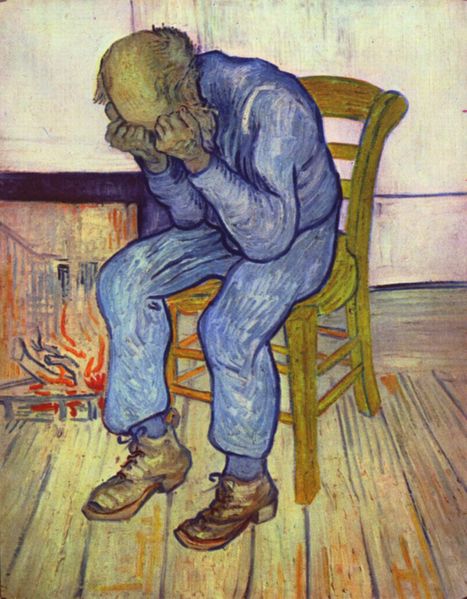Major depressive disorder historical perspective
 From Wikidoc - Reading time: 3 min
From Wikidoc - Reading time: 3 min
|
Major depressive disorder Microchapters |
|
Differentiating Major depressive disorder from other Diseases |
|---|
|
Diagnosis |
|
Treatment |
|
Follow-up |
|
Case Studies |
|
Major depressive disorder historical perspective On the Web |
|
American Roentgen Ray Society Images of Major depressive disorder historical perspective |
Editor-In-Chief: C. Michael Gibson, M.S., M.D. [1]
Overview[edit | edit source]
Clinical depression was originally considered to be a chemical imbalance in transmitters in the brain, a theory based on observations made in the 1950s of the effects of reserpine and isoniazid in altering monoamine neurotransmitter levels and affecting depressive symptoms.
Historical Perspective[edit | edit source]

Discovery[edit | edit source]
The modern idea of depression appears similar to the much older concept of melancholia. The name melancholia derives from "black bile", one of the "four humours" postulated by Galen.
Clinical depression was originally considered to be a chemical imbalance in transmitters in the brain, a theory based on observations made in the 1950s of the effects of reserpine and isoniazid in altering monoamine neurotransmitter levels and affecting depressive symptoms. [1] Since these suggestions, many other causes for clinical depression have been proposed.[2]
Some medical professionals and anthropologists have formed several theories as to how depression may have evolutionary advantages, i.e., how it might have increased genetic fitness in ancestral populations. For example, psychic pain may have evolved in an analogous way to physical pain so that organisms avoid behaviour that hinders reproduction. This insight may be helpful in counseling therapy. [3][4] Proponents of the psychic pain theory tend to view clinical depression as a dysfunctional extreme of low mood or mild depression.
Landmark events in development of strategies[edit | edit source]
- Insulin shock therapy is an old and largely abandoned treatment for severe depression, psychosis, catatonia, and other mental disorders. It consists of induction of hypoglycemic coma by intravenous infusion of insulin.
- Atropinic shock therapy, also known as atropinic coma therapy, is an old and rarely used method. It consists of induction of atropinic coma by rapid intravenous infusion of atropine. Atropinic shock treatment is considered safe, but it entails prolonged coma (between four and five hours), with careful monitoring and preparation, and it has many unpleasant side effects, such as blurred vision. [5]
- Treatment with psychotherapy including psychodynamic therapy and psychoanalysis was developed around the 19th century. [6]
- One of the first drugs used for the treatment of depression was imipramine. This was followed by other medications belonging to the class of tricyclic antidepressants (TCAs).
- Other antidepressants belonging to the class selective serotonin reuptake inhibitors (SSRIs) emerged
- Fluoxetine in 1987
- Sertraline in 1991
- Paroxetine in 1992
Famous cases[edit | edit source]
Numerous celebrities both dead and alive have been diagnosed with depression and spoken publicly about it. Some Hollywood celebrities include-
- Kristen Bell
- Jim Carrey
- Ellen Degeneres
- Cara Delevingne
- Johnny Depp
- Eminem
- Chris Evans
- Harrison Ford
- Joseph Gordon-Levitt
- Angelina Jolie
- Anne Hathaway
- Lady Gaga
- Hugh Laurie
- Dolly Parton
References[edit | edit source]
- ↑ Schildkraut, J.J. (1965). "The catecholamine hypothesis of affective disorders: a review of supporting evidence". Am J Psychiatry. 122 (5): 509–22.
- ↑ Castren, E. (2005). Is Mood Chemistry? Nat Rev Neurosci, : p6(3):241-6 PMID 15738959.
- ↑ Tony J. Carey (September 2005), "Evolution, depression and counselling", Counselling Psychology Quarterly, Volume 18, Number 3: 215–222
- ↑ Tom Geoghegan (Thursday, 28 February 2008), Is depression good for you? Check date values in:
|date=(help) - ↑ Haenel T (November 1986). "[Historical notes on the therapy of depression]". Schweiz Med Wochenschr (in German). 116 (47): 1652–9. PMID 3541174.
- ↑ Ebert A, Bär KJ (April 2010). "Emil Kraepelin: A pioneer of scientific understanding of psychiatry and psychopharmacology". Indian J Psychiatry. 52 (2): 191–2. doi:10.4103/0019-5545.64591. PMC 2927892. PMID 20838510.
 KSF
KSF